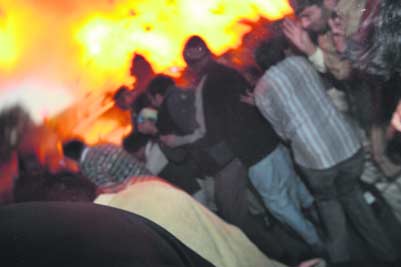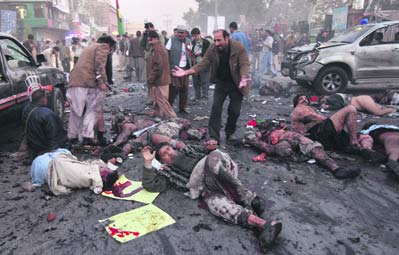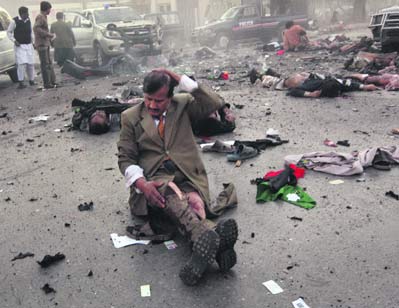Archive: The legacy of Benazir Bhutto
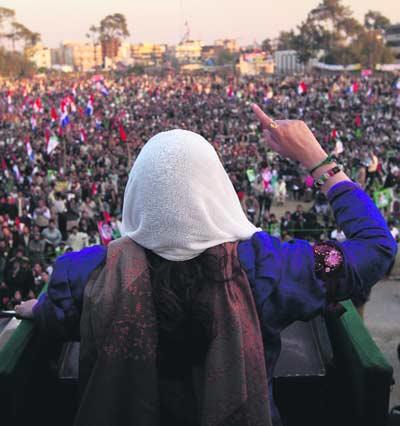
The former Pakistani Prime Minister, assassinated on 27 December 2007, herself danced with some of the lethal sectarian organisations that populate much of Pakistan.
By Prakash Kumar
The photodiary below capturing the events that immediately preceded and succeeded the killing of Benazir Bhutto were taken by the Getty Images photo-journalist, John Moore
New Delhi: The identity and precise affiliation of the killers of Benazir Bhutto may never be unraveled because of the multiplicity of jihadist organisations that now populate Pakistan: Al Qaida, Taliban, Jaish-e-Mohammed, Lashkar-e-Taiba and Lashkar-e-Jhangvi.
(Jaish-e-Mohammed, literally ‘The Army of Muhammad', founded in 1994 and committed to the separation of Kashmir from India, implicated for the kidnapping and murder of American journalist Daniel Pearl; Lashkar-e-Taiba, literally ‘Army of the Pure', has as its primary objective to end Indian rule in Kashmir; and Lashkar-e-Jhangvi is a sectarian Sunni organisation involved in the sectarian murder of Iranian air force cadets in the early 1990s.)
All these organisations have the same parentage and a common goal. They have been politicised on Pakistani land in hundreds of Wahabi-Deobandi-Ahle Hadith-oriented madrassas (schools) to fight the “Islamic war” against “infidels”.
(Wahhabism is a conservative 18th century reform movement of Sunni Islam founded by Muhammad ibn Abd-al-Wahhab. Wahhabism formed the creed upon which the kingdom of Saudi Arabia was founded and is the dominant form of Islam in several Islamic countries. The primary doctrine of Wahhabism is the uniqueness and unity of God. The Deobandi is a Sufi Islamic revivalist movement which started in India and has more recently spread to other countries, such as Afghanistan, South Africa and the United Kingdom. The Deobandi movement developed as a reaction to the British colonialism in India, which they believed to be corrupting Islam. Ahl Hadith is an Islamic school found predominately in the Middle East and South Asia, in particular, Pakistan and India. Its members reject the four major Sunni schools of Islamic law and emphasize what members say are the original principles
of Islam.)
The foundation of modern day jihad was not laid very long ago. In late 1970s, the US, wishing to counter an advancing Russian (then USSR) troops in Afghanistan, aligned with Pakistan to raise a strong band of well-trained militia capable of handling the most sophisticated warheads and rocket launchers.
The US-Pakistan axis found a voluntary donor in Saudi Arabia, which extensively funded the growth of Wahhabi-Deobandi Sunni madrassas (schools) in Pakistan and in its North West Frontier Provinces that eventually became the militants' breeding ground.
The rise of Islamic fundamentalism in Pakistan, besides catering to the US game plan, served the interest of then military dictator General Zia ul Haq, who wanted to curb the influence of the Shia community within Pakistan.
The birth of Sipah-e-Sahaba Pakistan (SSP) in 1979 is credited to Zia-ul-Haq, who followed the Deobandi school of Sunni sect. Zia's purpose was not only to counter the Shias, but also marginalize all pro-democracy forces seeking an end of his regime.
(Sipah-e-Sahaba Pakistan (SSP), is a Sunni sectarian organsiation allegedly involved in terrorist violence, primarily targeting minority Shia Muslims in Pakistan. It has also operated as a political party, having contested elections. The SSP is alleged to have been established at the instigation of the Zia-ul-Haq regime as part of the efforts to resist pro-democracy forces ranged against it.)
While Osama bin Laden was given the task of regrouping hardcore Arab fighters to wage war against the troops of erstwhile USSR in Afghanistan, Pakistan-based groups such as the SSP assisted him in providing fresh recruits drawn from countries in the sub-continent.
Thus the foundation for a global jihad was laid.
After the withdrawal of the Russian troops from Afghanistan in 1988, bin Laden and his forces were diverted to other countries with the objectives of keeping their pan-Islamic interest intact and, at the same time, keeping the option of using this reserve, trained in modern warfare, to target another common enemy at any future date by the allied forces.
By 1996, even when the honeymoon between the jihadis and the US-Pak axis had almost come to an end with some of them having already fought against the Americans in Somalia, the ISI (Pakistani intelligence service) again requisitioned the services of bin Laden in Bosnia to put a resistance to Serbs.
Bin Laden had again been brought back (in 1996) and rehabilitated in Jalalabad (Afghanistan) with the consent of both the US and then Pakistani premier Benazir Bhutto. The Al Qaida mastermind, who had spent time in Saudi Arabia and Sudan after the Afghan war, regrouped the leftovers of the conflict under International Islamic Front (IIF), his new banner.
The IIF had representation from Lashkar-e-Taiba (LeT), Jaish-e-Mohamad (JeM), HuJI and SSP from Pakistan besides representation of militant outfits from Egypt, Uzbekistan, Philippines and Xinjiang. The Harkat-ul-Mujahideen and Harkat-ul-Jihad Islami (HuJI), which had merged to form Harkat ul Ansar and fought alongside Taliban had later split into JeM and HuJI.
(Harkat-ul-Ansar (HUA) was an Islamic militant organization founded in 1993. Many of its operations were conducted in Jammu and Kashmir.)
Similarly, the Lashkar-e-Jhangvi is nothing but the armed wing of the SSP like LeT which is the armed wing of the Jamaat-ud Dawa.
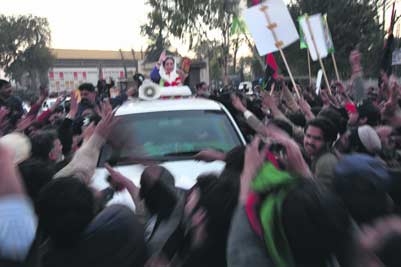
Above: Former Prime Minister Benazir Bhutto waves to the crowd from her car following a political rally in Rawalpindi, Pakistan on December 27, 2007.
Below: Seconds later a bomb explodes beside Bhutto's vehicle killing Bhutto and 20 others.
